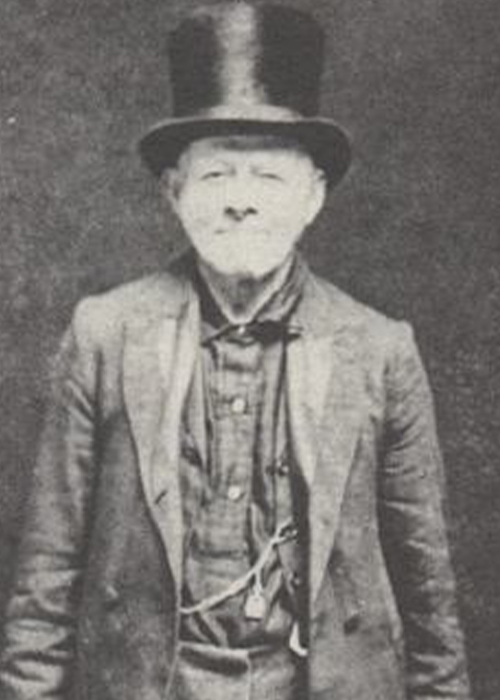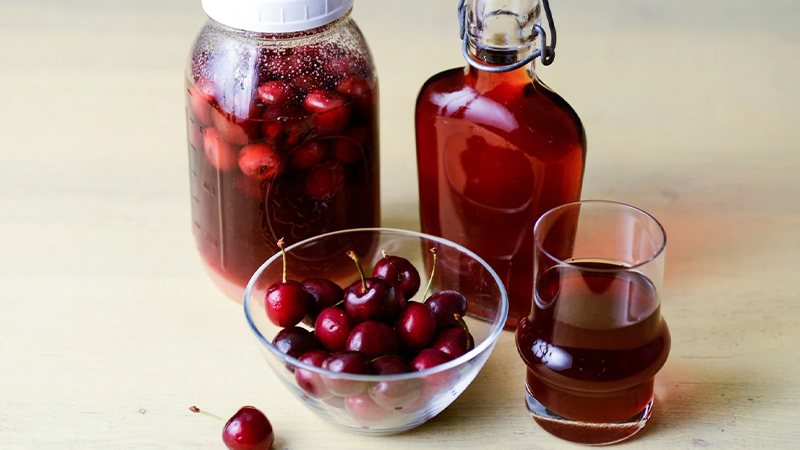Between mid-July and mid-August, Wisconsin’s Door County begins its cherry harvesting season. Summer also marks the time when locals prepare their versions of a cordial known as “cherry bounce.”
Within this peninsula between Green Bay and Lake Michigan, residents head to orchards during the summertime to pick and purchase cherries to make this fruity concoction. After being combined with sugar and a spirit of their choosing — common options being brandy, vodka, bourbon, or rum — the mixture is tightly stored in a glass jar to meld until the winter holiday season.
“Cherry bounce is basically fresh cherries soaked in a liquor of your choice,” says Beth Levendusky, marketing director at Door Peninsula Winery and Door County Distillery in the county’s Sturgeon Bay. “It’s almost cultural in Wisconsin, I would say, especially in the Door County area, where we grow many cherries.”
Don’t miss a drop!
Get the latest in beer, wine, and cocktail culture sent straight to your inbox.
Cherry bounce is believed to have originated in 17th-century England from Frithsden, a hamlet in Hertfordshire. A brandy-based version was among George Washington’s favorite libations, with a recipe found in his wife Martha’s records. It’s also linked to other parts of the country; in North Carolina, moonshiner Amos Owens made his with honey and a corn-based whiskey.

Door County’s ties to cherry bounce involve its farming legacy, as cherries have been grown there since the late 19th century. According to the Wisconsin Cherry Growers’ website, A.L. Hatch, a fruit grower, and Emmett Stull Goff, a professor of horticulture at the University of Wisconsin, planted the first cherry trees on the peninsula in 1896. Today, Door County sees 8 to 12 million pounds of cherries harvested annually from more than 2,000 acres of cherry orchards, accounting for 10 percent of all cherries grown in the U.S.
The most prominent variety used in cherry bounce is the Montmorency cherry, which is tart in flavor and brightly red in color. “We call it tart; some people call it sour,” said Carrie Lautenbach-Viste, director of marketing at Lautenbach’s Orchard Country Winery & Market in the county’s Fish Creek. “But we think ‘tart’ is a little bit more of a positive word.”
When choosing your spirit for cherry bounce, Levendusky says, think first about what kind of flavor you’d like. “If you want something neutral, where you really want the cherry to stand out, then you’re going to want to go with a vodka,” she explains. “Or you can even use a rum or something like that where it’s a little more mellow.”
Locally, a popular choice is brandy, as Wisconsin is a major consumer market for the spirit. In fact, Korbel, a California-based wine and brandy producer, shipped over half of its brandy supply to the state in 2019.
Its versatility is perhaps what makes cherry bounce maintain its popularity. Brad Birmingham, owner of Birmingham’s, a bar and restaurant in the county’s Sturgeon Bay, notes that while other cherry varieties can be used, Maraschinos don’t turn out well. Some makers might add in cloves, nutmeg, cinnamon, or honey in place of sugar, while others go for unique spirit choices. “Some people like it stronger, so they put Everclear in,” he says. “But you can [also] make them with amaretto and crème de cacao.”
Mason jars or any jar with a tight seal work best in cherry bounce making. First, fill up a jar at least halfway with cherries, and then pour the spirit into all spaces in between. Store it in a place with a cool temperature and away from the sunlight.

“The longer it sits, the more you’re going to extract those cherry juices, and the more you’re going to get a mellow cherry spirit,” says Levendusky. The cherries will also become quite potent and could be mixed with a seltzer or soda to tone down their alcohol level. They also do well in an Old Fashioned; Wisconsin’s version is made with brandy and “bug juice,” and can also include an orange slice, a cherry, and a sugar cube.
The reason behind the many cherry bounce iterations — and lack of a single go-to recipe — is that crafting cherry bounce is often a family tradition, with recipes that are passed down from generation to generation. “A lot of recipes are tried and true; they are generally family recipes made over and over again,” says Birmingham.
These family recipes are put on display each year at Birmingham’s annual Cherry Bounce contest, held on the last Saturday in January since 2003. To date, the largest number of entries has been 53, and Birmingham says both traditional and interpretive takes are accepted.
Judging starts with all entries placed on different tables; the top three chosen entries per table advance to a “final table.” Experimental entries have ranged from a cherry bounce cake to white-, milk-, and dark-chocolate-covered cherries.
Each year’s champion wins a grand prize of a toilet seat, inscribed with the year and their recipe. It’s then custom for winners to pose for a photo with their prize. “We’ve had some winners that are no longer with us, so it’s always memorable to look back at the pictures that we have,” says Birmingham. “We make a little note each year and reminisce a little bit about those winners and the recipes.”


